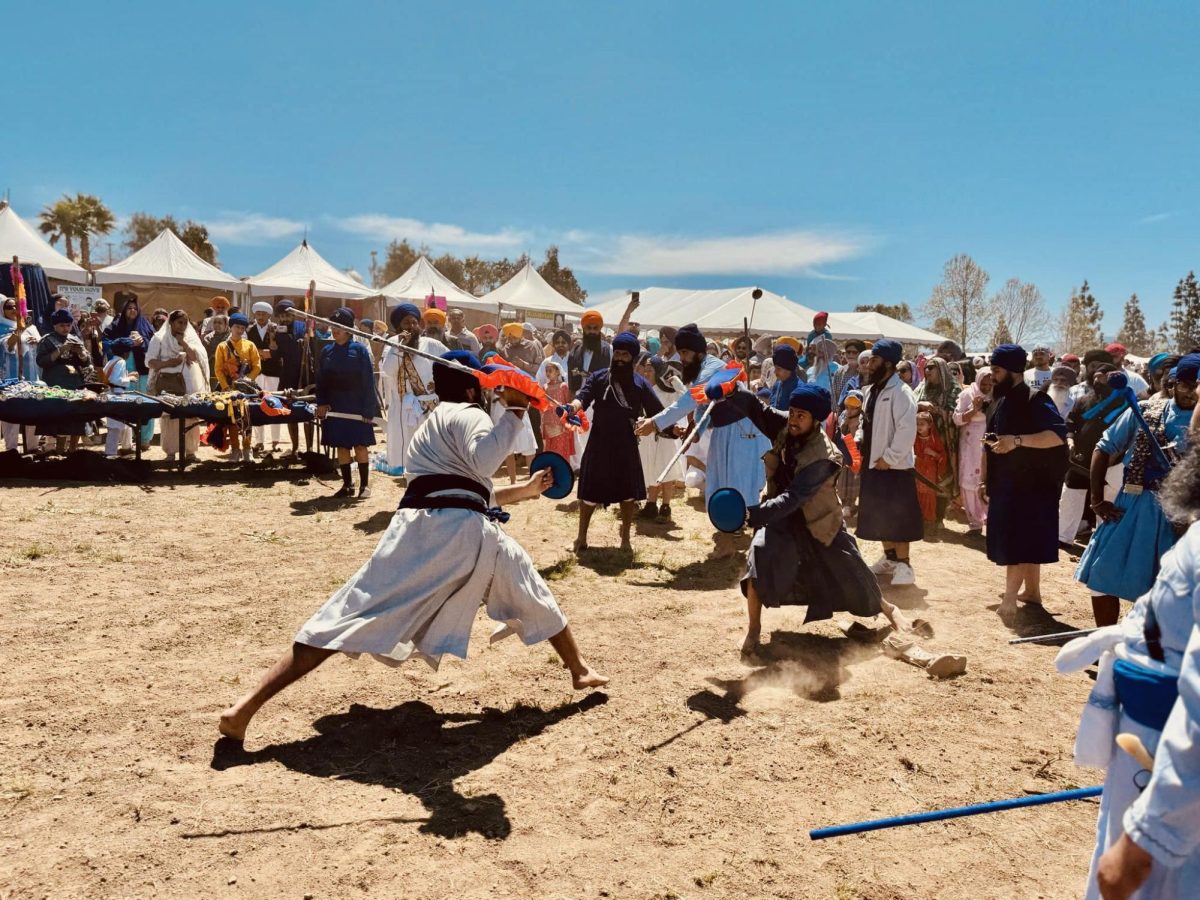Originating in the historic city of Anandpur in India, Hola Mohalla is an annual three-day festival transcending borders and cultures, resonating in Sikh Gurdwaras worldwide. This vibrant celebration not only pays homage to the Sikh warrior spirit but also serves as a testament to the global unity and resilience of the Sikh community.
Today, Sikh Gurdwara San Jose hosts one of the largest Hola Mohalla celebrations in the Western world. Sikhs from across the United States, Canada, and the United Kingdom gather at the gurdwara to partake in these joyous festivities.
The History of Hola Mahalla
The term “Hola” in Punjabi roughly translates to “the onset of an attack,” while the Arabic-derived term “Mohalla” translates to “an army battalion or regiment.”
Hola Mohalla is generally celebrated a day after the Hindu festival of Holi. It takes place on the second day of Chet in the Sikh Lunar calendar called the Nanakshahi calendar.
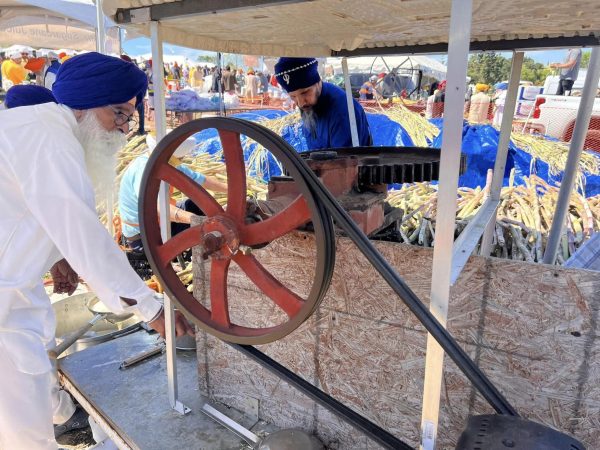
The festival dates back to 1701 in the village of Anandpur, which marks the birthplace of the Khalsa — referring to the collective body of initiated Sikhs who have undergone the Amrit ceremony, committing themselves to the Sikh faith’s principles of selfless service, devotion, and righteousness.
Guru Gobind Singh Ji, the 10th Sikh guru, established Hola Mohalla as a platform for Sikh warriors across India to display their martial prowess and strengthen their bonds of camaraderie and brotherhood. Activities typically included horseback riding, Gatka — a traditional Sikh martial art — and mock battles, where Sikh warriors were divided into teams to re-enact historical battles. During this time, many Sikhs were baptized and trained spiritually and physically.
The Importance of Shastar (Weapons) in Sikhism

“Dharam Yudh” is a core tenant of the Sikh faith. The term translates to “the war of righteousness,” illustrating that when all other means of justice have been exhausted, it is permissible to take to the sword.
The “kirpan,” a small, dagger-like weapon, is one of the five aspects of the Sikh uniform.
“In the Dasam Granth (a collection of hymns written by Guru Gobind Singh Ji), we recite the hymn ‘jai jai jag kaaran sirasat ubaaran mam pratipaaran jai tegan.’ This line praises the creation of the sword, or the ‘teg’ which has been created to protect those who need protection,” said Veer Singh, an attendee at the event. “The kirpan is different from a sword. This has been highlighted in our scriptures. The word ‘kirpa’ means to bestow an act of kindness, and ‘aan’ means ‘honor.’ Sikhism clearly shows that the kirpan cannot be used for self-serving or nefarious purposes. It is only permissible to use the kirpan when it is in the defense of oneself or of others.”
Before observing “Sanatan Shastar Vidhya,” more commonly known as simply “Shastar Vidhya,” the science of weaponry, Sikh soldiers are required to say an “ardaas” –– a salutation prayer — in which the practitioner respectfully salutes and bows to the weapons out of reverence. It is common for particular hymns from the Dasam Granth to be recited as an incantation, such as excerpts from “Shastar Naam Maala” — a hymn attributed to Guru Gobind Singh ji in praise of God, which uses various weapons as metaphors — and other similar hymns. The practice of weapon worship is common in Sikhism and is known as “Shastar Puja.”
There are various aspects of Shastar Vidhya. These branches are typically called “ang.” Per The Oxford Handbook of Sikh Studies published by Kamalroop Singh, the branches are as follows:
- Bahu Yudh – unarmed combat
- Loh Musti – iron fist fighting
- Mal Yudh – wrestling
- Gatka (Gada Yudh) – stick/club fighting, containing a unique style of combat known as Gatka
- Shastar Yudh – weapon fighting
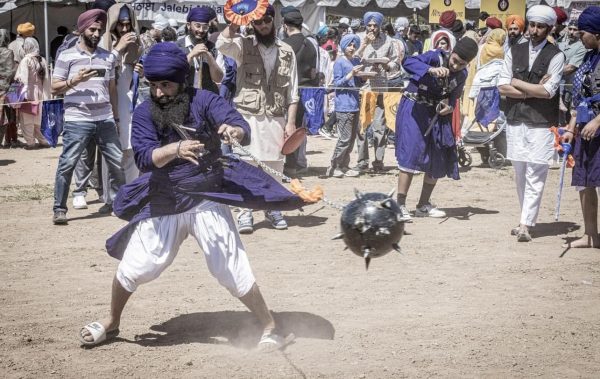
“Guru Gobind Singh made it clear that to have Shastar Vidhya, a Sikh must also have Shaastar Vidhya (religious studies). The two go hand-in-hand. The sixth guru, Guru Hargobind ji, carried two swords, ‘Miri’ and ‘Piri,’ to signify worldly prowess and spiritual prowess. Without understanding one’s religious responsibilities, one cannot wield a kirpan, they’re merely wielding a sword,” said Professor Manjeet Singh, a Sikh scholar, and preacher.
For generations, the San Jose Sikh Gurdwara has developed a comprehensive, volunteer-run program for young Sikhs, offering language studies, Sikh history classes, kirtan (instrumental and vocal hymn performance) sessions, and Shastar Vidhya training. Structured in levels, these year-long courses provide young American Sikhs with an opportunity to connect deeply with their culture and acquire the balance of Shastar and Shaastar Vidhya essential to embody the Sikh identity.
The Sikh Spirit of Chardikala
The term “chardikala” is often used in Sikh greetings, but it loosely translates to “high spirits” or “eternal optimism.” This spirit of chardikala permeated throughout the Hola Mohalla event.
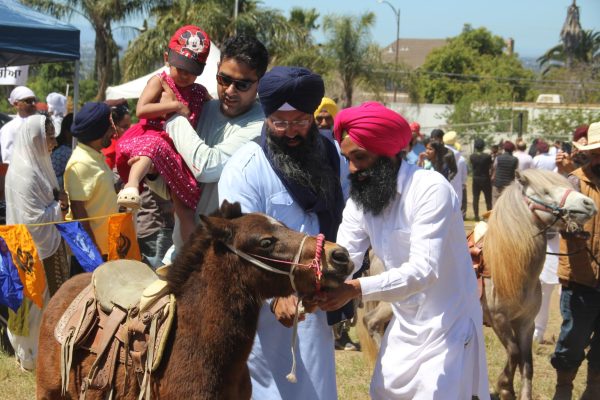
People from all corners of the globe, irrespective of their religious or ethnic backgrounds, come together to participate in a volunteer-driven langar service. This service offers free vegetarian meals, featuring dishes like naan, choley (spiced chickpeas), kulchey (stuffed flatbread), pakorey (fried fritters), tandoori vegetarian pizza, and a variety of other offerings.
Numerous clothing and jewelry stalls showcased traditional garments and accessories alongside religious books and art displays. Adjacent to these were informational booths offering voting advisories, career guidance stalls, and advertisements for college preparation programs, accessible to all attendees.
This year, some Sikhs also gathered to protest against the Indian government for its alleged human rights violations against the Indian-Sikh population and spread awareness about the second Farmers’ Protest taking place in India to advocate for a mandatory minimum wage and fair trading practices for Indian farmers.
The event also consisted of “Dhaadi Vaaran,” a practice started by Guru Hargobind Ji, in which a small group of religious instrumentalists and vocalists retell events in Sikh history in a mixture of an oratory and musical format. These stories, also known as “saakhiaan,” often retell the stories of brave soldiers and martyrs to instill a spirit of chardikala and inspiration amongst audiences.
The event also featured a week-long kirtan program, showcasing musical hymns by renowned raagi jathas — religious musical groups skilled in singing kirtan in specific raagas. Many hymns resonated with springtime themes and the warrior spirit, further amplifying the essence of Hola Mohalla.
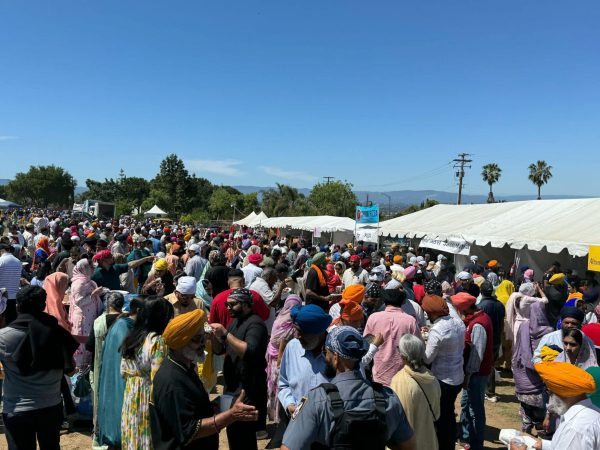
“As a local, I am always looking forward to events like Hola Mohalla and the Nagar Kirtan. Honestly, I am always so refreshed to see the spirit of Hola every year. There are tens of thousands of attendees, and sevadars (volunteers) invite everyone to enjoy free food and participate in the festivities,” said Mollie Henderson, an event attendee. “I love the variety of food and beverages available, and there’s always extra to take home.”
Sikh Gurdwara San Jose welcomes people of all faiths and backgrounds to join in the festive celebrations of Hola Mohalla, savor the free langar, engage in activities, and discover Sikh culture. Perhaps next year, you can also embrace the spirit of chardikala and participate in this uplifting event.
*All interviews mentioned in this article were conducted in Punjabi and the responses have been translated into English by Jasneh Sasan.

